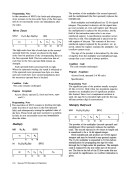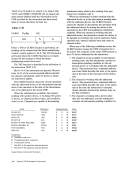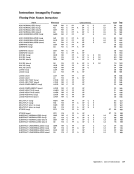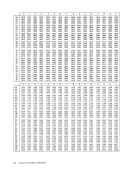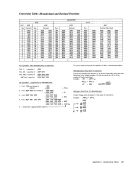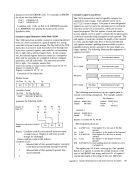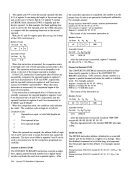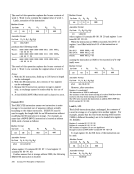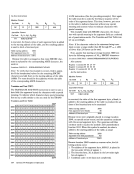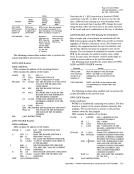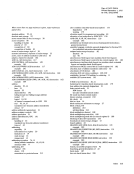one's complement of a number is obtained by invert
ing each bit of the number.
In an arithmetic operation, acarry out of the in
teger field changes the sign. However, in algebraic
left-shifting the sign bit does not change even if sig
nificant high-order bits are shifted out.
Programming Note
The integer part of a signed fixed-point number may
be considered to represent a positive value, with the
sign representing a value of either zero or the maxi
mum negative number.
Instructions
The general instructions and their mnemonics, for
mats, and operation codes are listed in the following
table. The table also indicates when the condition
code is set and the exceptional conditions in operand
designations, data, or results that cause a program
interruption.
Note: In the detailed descriptions of the individual
instructions, the mnemonic and the symbolic oper
andSystem/370 assembly
language are shown with each instruction. ForLOAD AND TEST, for example, LTR is the mne
monic and R 1, R2 the operand designation.
Add
AR [RR]
o 8 12 15
A [RX]
5A
o 8 12 1620 The second operand is added to the first operand,
and the sum is placed in the first-operand location.
31
Addition is performed by adding all 32 bits of
both operands. If the carry out of the sign-bit posi
tion and the carry out of the high-order numeric bit
position agree, the sum is satisfactory; if they disa
gree, an overflow occurs. The sign bit is not changed
after the overflow. A positive overflow yields a neg
ative final sum, and a negative overflow results in a
positive sum. The overflow causes a program inter
ruption when the fixed-point overflow mask bit is
one.
Resulting Condition Code:
oSum is zero
1Sum is less than zero
2Sum is greater than zero
3 Overflow
Program Exceptions:
Access (fetch, operand 2 of A only)
Fixed-Point Overflow
Programming Note
In two's-complement notation a zero result is always
positive.
Add Hal/word
AH [RX]
4A
o 8 12 1620 The second operand is added to the first operand,
and the sum is placed in the first-operand location.
The second operand is two bytes in length and is
considered to be a 16-bit signed integer.
31
The second operand is expanded to 32 bits before
the addition by propagating the sign-bit value
through the 16 high-order bit positions. The con
tents of the second operand in main storage remain
unchanged.
Addition is performed by adding all 32 bits of
both operands. If the carry out of the sign-bit posi
tion and the carry out of the high-order numeric bit
position agree, the sum is satisfactory; if they
disagree, an overflow occurs. The sign bit is not
changed after the overflow. A positive overflow
yields a negative final sum, and a negative overflow
results in a positive sum. The overflow causes a pro
gram interruption when the fixed-point overflow
mask bit is one.
Resulting ConditionCode: o Sum is zero
1Sum is less than zero
2Sum is greater than zero
3 Overflow
Program Exceptions:
Access (fetch, operand 2)
Fixed-Point Overflow
General Instructions 117
ing each bit of the number.
In an arithmetic operation, a
teger field changes the sign. However, in algebraic
left-shifting the sign bit does not change even if sig
nificant high-order bits are shifted out.
Programming Note
The integer part of a signed fixed-point number may
be considered to represent a positive value, with the
sign representing a value of either zero or the maxi
mum negative number.
Instructions
The general instructions and their mnemonics, for
mats, and operation codes are listed in the following
table. The table also indicates when the condition
code is set and the exceptional conditions in operand
designations, data, or results that cause a program
interruption.
Note: In the detailed descriptions of the individual
instructions, the mnemonic and the symbolic oper
and
language are shown with each instruction. For
monic and R 1, R2 the operand designation.
Add
AR [RR]
o 8 12 15
A [RX]
5A
o 8 12 16
and the sum is placed in the first-operand location.
31
Addition is performed by adding all 32 bits of
both operands. If the carry out of the sign-bit posi
tion and the carry out of the high-order numeric bit
position agree, the sum is satisfactory; if they disa
gree, an overflow occurs. The sign bit is not changed
after the overflow. A positive overflow yields a neg
ative final sum, and a negative overflow results in a
positive sum. The overflow causes a program inter
ruption when the fixed-point overflow mask bit is
one.
Resulting Condition Code:
o
1
2
3 Overflow
Program Exceptions:
Access (fetch, operand 2 of A only)
Fixed-Point Overflow
Programming Note
In two's-complement notation a zero result is always
positive.
Add Hal/word
AH [RX]
4A
o 8 12 16
and the sum is placed in the first-operand location.
The second operand is two bytes in length and is
considered to be a 16-bit signed integer.
31
The second operand is expanded to 32 bits before
the addition by propagating the sign-bit value
through the 16 high-order bit positions. The con
tents of the second operand in main storage remain
unchanged.
Addition is performed by adding all 32 bits of
both operands. If the carry out of the sign-bit posi
tion and the carry out of the high-order numeric bit
position agree, the sum is satisfactory; if they
disagree, an overflow occurs. The sign bit is not
changed after the overflow. A positive overflow
yields a negative final sum, and a negative overflow
results in a positive sum. The overflow causes a pro
gram interruption when the fixed-point overflow
mask bit is one.
Resulting Condition
1
2
3 Overflow
Program Exceptions:
Access (fetch, operand 2)
Fixed-Point Overflow
General Instructions 117









































































































































